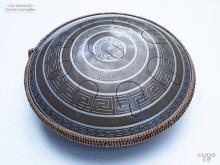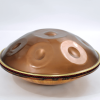
Tongue pan - new name for a new instrument.
Tongue pan (tongue handpan) was a new term that appeared on the Internet in the field of tongue drums during 2016-2017.
Our workshop also often uses this name and in this article, we will try to explain our understanding of this term and our reasons for its use.
We have to go back a little in time to do that. So let`s get started. First, a little bit of history.
Metal tongue drums (Steel tongue drum), unlike their ancient ancestors - wooden tongue drums, is a rather young form of musical instruments. The first copies of idiophones of this class appear more recently, around 2005-2006. From the first days of the appearance, the popularity of these drums has been growing rapidly. This is due to many reasons, but main - loud, bright and unusual sound, small size and relatively low price (comparing to handpans)
The decisive factor in the rapid spread of these instruments was the external similarity of the drums to the Swiss Hang (by PanArt), which was already incredibly popular at that time. Nevertheless, the Hang, due to the complexity and exoticism of the manufacturing technology, was very hard to obtain for everyone, and all the analogs of the Hang, that could somehow compete with the original in sound and quality, had not yet appeared.
A peculiar vacuum has emerged at availability in the market and it began to fill rapidly with metal tongue drums of a wide variety of manufacturers (the most popular name for such kind of tongue was "tank drum", because lots of them were made from propane tanks). As a rule, these were products of small craft workshops. Each of them tried to make its drums unique and not similar to others. The instruments differed in size, shape, appearance, number of notes, color and design, but as a rule they all had similar sound. The sound of most tongue drums was bright, loud, but with a large amount of metallic hum and parasitic dissonant overtones. The similarity of the sound was due to the similarity of manufacturing technology. In fact, it was all the same and differed only in nuances.
Tongue pan - descendant of handpan and tongue drum
Eventually, around 2012-2013, some manufacturers begin to experiment with the core principles of manufacturing such instruments. Emergence of a large number of analogs of the Hang named Handpans begins to have the decisive influence on the new creative search for their sound. Tongue drum craftsmen are eager to repeat the fascinating sound of the Hang and handpans in their instruments. To do this, they adopt a part of the technology of handpans. In particular, they borrow the key principle of tuning - tuning up of several notes on the same sound field. The first generation of the Hang (and his ancestor Steelpan) had two notes tuned on the membrane (tone and overtone), that gave an incredible fullness of sound. Tongue drum craftsmen begin to use similar processes for the preparation of raw materials, and also begin to tune several notes on one sound tongue (petal) in an effort to increase the density and brightness of the sound to make it more voluminous and juicy.
However, the result exceeded all expectations. This not only turned out to be possible, but the resulting instrument in its sound became very different from metal tongue drums and handpans, but with specific features of the instruments of those classes.
In order to highlight this new kind of tongue drums, some workshops began to use the additional name - tongue pan. Literally, this means "tongue handpan", i.e., tongue drum that was made according to the principle of handpan and having the characteristic features of the instruments of that class. Also, the most striking distinctive features - tongue pan can include such characteristics as tuning of two or more notes on the same petal, the absence of a loud metal buzz of the body and the resonator chamber, the absence of bright discordant parasitic overtones, dry ceramic ping, and moderate sustain (5 -10 sec.)
Our workshop accepts and uses this name to designate our instruments, considers it correct and wright. It must be noted, that the instruments under the term «tongue pan» on the market are proportionally much fewer than standard tongue drums.
Now, this class is even a certain rarity. The complexity of the technology and the tuning of these drums are much higher, so it increases their price. It should also be understood that even in the assortment of our workshop, not all drums can be classified as “tongue pan”.
For example, Freezbee, Neo 8 (Neo 9) and Guda Ortus Aluminum tongue drums do not belong to the tonguepan class, due to the only one note on the petal. In our assortment, “tongue pan” includes Guda Plus and Guda Standard, and the most bright representatives of this class are our premium instruments — Guda Double, Guda Ortus Brass and Guda Coin.
Alex Lozhkin, Max Plakhtin






